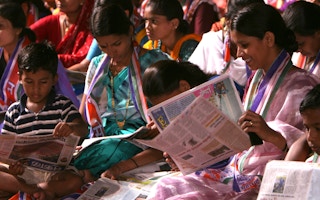Campaign rallies under a blazing sun, long treks to rural polling stations - as Indians prepare to vote, forecasts for extreme heat could add to the challenges of holding the world’s biggest election.
With voting starting on Friday, parties and authorities are being urged to do more to keep voters, candidates and polling station staff safe following heat warnings by the nation’s meteorological service for the six-week election period.
During India’s April-June hot weather season, various parts of the country could record 10 to 20 heatwave days compared to the normal four to eight, head of the Indian Meteorological Department (IMD) Mrutyunjay Mohapatra said earlier this month.
“Most parts of south peninsula, central India, east India and plains of northwest India will experience above normal heatwave days with temperatures hitting or crossing 40 degrees Celsius (104 Fahrenheit),” Mohapatra told Context.
While hot weather is part of everyday life in much of the country of 1.4 billion people, the intensity and frequency of heatwaves in India is rising due to climate change, increasing the risk of working or other outdoor activities.
Eleven people died and several more were hospitalised with heatstroke after they attended a political event held under the afternoon sun in Maharashtra last April.
“
Most parts of south peninsula, central India, east India and plains of northwest India will experience above normal heatwave days with temperatures hitting or crossing 40 degrees Celsius (104 Fahrenheit).
Mrutyunjay Mohapatra, head, Indian Meteorological Department
Anxious to avoid similar tragedies, the Election Commission of India has instructed electoral officers in each state to raise awareness about the dangers of extreme weather conditions and take steps to help voters cope with the scorching heat.
The measures for polling stations include ensuring the availability of drinking water, rigging up canopies for shade and providing childcare facilities.
They will also need to have medical kits, healthcare volunteers and ambulances on hand on voting days.
“A billion people will come out to vote … It’s going to be very challenging for us,” Kiren Rijiju, India’s earth science minister, said this month. “All the states have made elaborate preparations.”
However, electoral authorities have issued no specific heat guidance for campaign rallies.
“There should be strict guidelines on hours of the day when rallies and meetings can be organised, if there is a heatwave,” said Dileep Mavalankar, the former director of Gandhinagar-based Indian Institute of Public Health.
Rallies should be suspended or moved indoors where possible, ambulances and paramedics should be on hand and local hospitals on standby, said Mavalankar, who helped draw up India’s first heat action plan for the city of Ahmedabad in 2013.
Heat stroke risks
Heat stress occurs at temperatures above 35°C (95°F) in high humidity, according to the International Labor Organization. Heat stroke can occur if body temperature rises above 40°C, with children, the elderly and people with pre-existing conditions most at risk.
Government authorities should make people aware of the risks, but are often blasé about the dangers, said Abinash Mohanty, a climate scientist and sector head for climate change at IPE Global, an international development organisation.
“Elections … can also be an opportunity to increase awareness around the risks of heat especially around its health impacts,” Mohanty said.
In the southern state of Telangana, Anvesh Reddy, a politician with Kisan Congress, said the party was taking its own precautions as temperatures top 40°C.
“We have mostly been meeting voters between 6 a.m. and 10 a.m. in the morning and then after 5 p.m. in the evening,” Reddy said.
A political consultant from Maharashtra echoed Mavalankar’s calls for specific guidelines on organising rallies.
”(That) could help ensure that no party takes rally management lightly, as they would not want to give opposition any excuse for criticism,” said the consultant, who asked not to be named because he works for several different parties.
Campaign events in large venues usually have medical staff on duty, but they are “just there to tick the box”, said another political consultant in the northern state of Uttar Pradesh.
“If a tragedy like the one is Maharashtra last year happens again at a rally, the capacity is never enough compared to the number of people in attendance.”
This story was published with permission from Thomson Reuters Foundation, the charitable arm of Thomson Reuters, that covers humanitarian news, climate change, resilience, women’s rights, trafficking and property rights. Visit https://www.context.news/.








